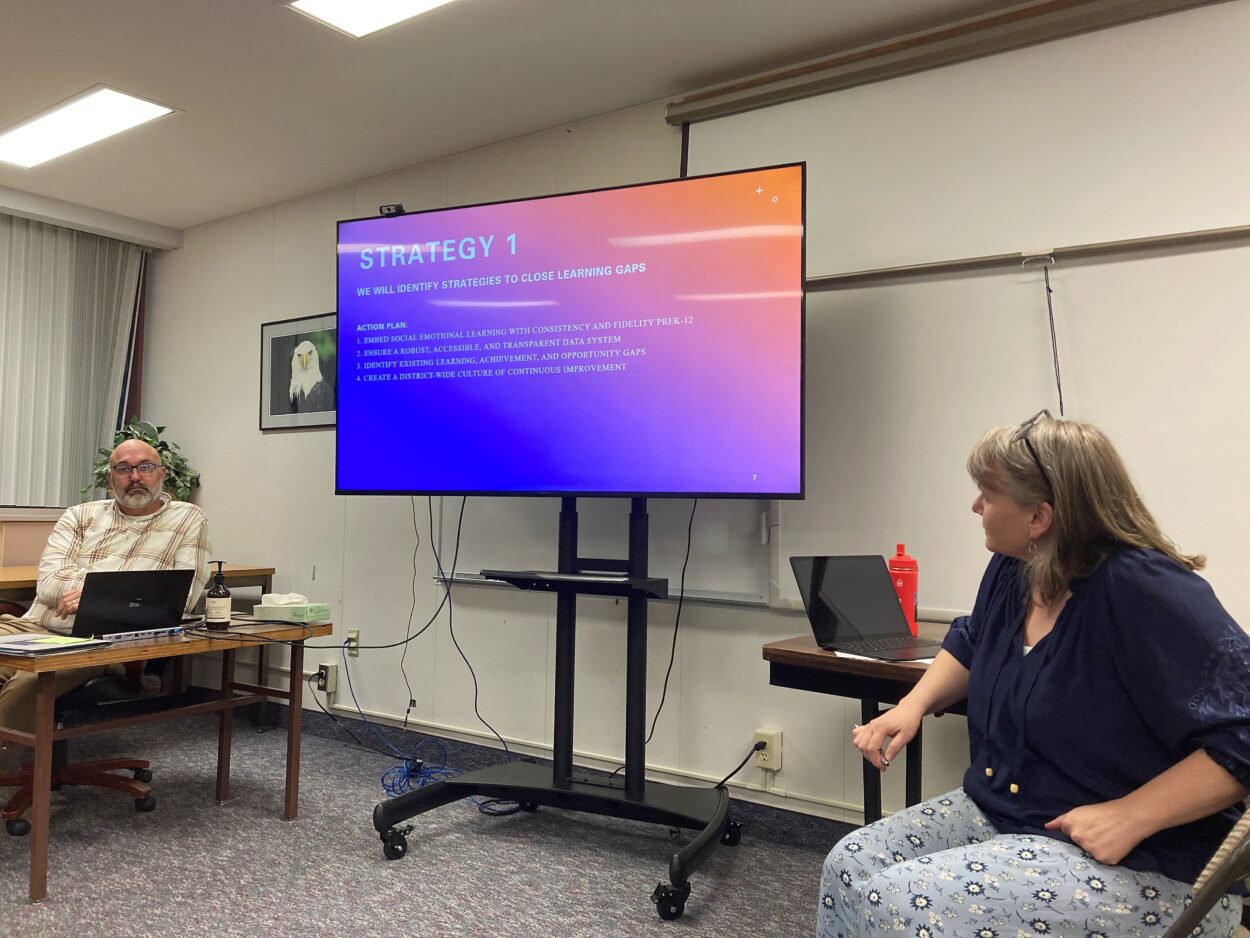
The Sitka School District is trying to get the ball rolling again on its strategic plan, but there’s not agreement yet over what that “ball” is.
Educators and school board members met Wednesday night (9-13-23) to pick up the threads of a planning process that had just begun when it was interrupted by the pandemic in 2020. The group decided that the first task now was to reassess some of that work, and decide what’s achievable in the near term.
Strategic planning doesn’t sound like the most exciting topic, but you can’t argue with the results: Sitka’s Wooch.een Preschool emerged from strategic planning; so did the emphasis on student emotional health that saw the district put a trained counselor in every building. Have you been enjoying City League Basketball or Volleyball? Sitka’s Parks and Recreation Office was an idea that came out of strategic planning, after district budget cuts forced the closure of a very popular Community Schools program.
At the first meeting of 2023, there were no concrete ideas on the table; the planning process had not got that far in 2020. Instead, there were six broad goals like “we will identify strategies to close learning gaps,” or “we will strengthen culturally responsive programming.”
Each one of those goals had five or six “action plans.”
Assistant superintendent Deidre Jenson, in her first year in the district, stepped into the role of facilitator, and invited many of the district staff who worked on the plan before the pandemic to come back and refocus.
“If you are juggling so many balls, there’s going to be ones that drop,” Jenson said, “or you’re just doing so many jobs, you’re not going to really do any of them well. So I think that is a good question: Which ones are priorities? And how do we decide those priorities?”
The number one goal of the district for at least two decades has been to close the “learning gap,” the difference in achievement between different student demographics, the most glaring being the difference between Native and non-Native student populations. There was consensus that the other five goals were all indirectly related to this one, like a Venn diagram of circles and arrows.
Sitka High math teacher Ryan Myers said that the results of strategic planning should be quantifiable.
“You cannot have an intelligent conversation about how any of these things go, if you don’t know where you were, and you have no way of measuring where you’re going,” Myers said. “So I’m very happy to pick three or four things or whatever we want to do. But it has to start with, Where are we now? What do we have? And then, What is success going to look like?”
The conversation touched briefly on the cost of implementing new programs, both in actual money and in human resources. Former assistant superintendent Sarah Ferrency, who now is the education director for the Sitka Tribe, observed that education research had demonstrated that success often meant trade-offs.
“What they actually found is that if you implement something a little, you get nothing. If you implement something medium, you get nothing,” she said. “You really only get results when you fully implement with fidelity and consistency. So it really is prioritization and focusing, and focusing all of your resources – your human resources, your financial resources. And that does mean something’s going to have to go away, which is very difficult in public schools.”
Tim Pike agreed. In addition to teaching in the Career and Technical Education program at the High School, Pike sits on the Sitka Assembly. He thought that strategic planning was really about deciding where to effectively spend money.
“The strategic plan is also to drive resources in a particular direction,” said Pike, “and to make sure that the financial and human resources go where we need them to go. And I’ll just circle back to what I said before, there’s way too much stuff up here for us to implement. And I think you see that as the result is why we’re here now. Right now, it’s not an implementable plan.”
Although the school board ultimately will sign off on a final strategic plan, it’s the district staff and community partners like the Tribe and the Sitka Sound Science Center who will make it happen. When the board suggested waiting to move forward until a permanent superintendent had been hired after this “transition year,” Ferrency pushed back, arguing that students themselves were the critical timeline, rather than teachers or administrators.
“We’ve been in transition for four years now,” she said. “So the kid who was in kindergarten in 2020-21 is now in third grade. And guess what? Those are the crucial years for learning to read. So if that kid has not learned to read now, and if we every year say ‘Well, it’s a transition year,’ the average tenure for a superintendent in the state of Alaska is three years.”
In the end, everyone agreed more discussion was needed to pare down the list to a couple of achievable priorities, and implementable action plans. The administration will present a proposed schedule for additional work sessions on strategic planning for the board to adopt at its next regular meeting.






























